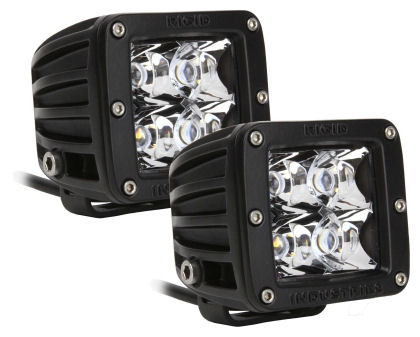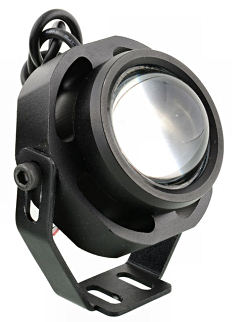Auxiliary LED Lighting for Motorcycles
If you're going to add extra lighting, either to see better in the dark or be seen better during the day, LEDs (Light Emitting Diodes) are the way to go. For a given light output they draw less power and generate less heat than any other light source. There are lots and lots of aftermarket bolt-on LED lights for bikes and cars. Prices range from maybe $10 at the low end to over $600 at the high end. The difference will be in construction quality, light output and where you buy them from.

Rigid Off Road LED Lights
There are a few things to be aware of though. Extra lights on a vehicle are regulated by both the Federal government and State DMVs. You can't just bolt on as many lights as will fit and use them all the time when you're on the road. If you're off road you can do whatever you want, but on the road there are rules. The basic federal rule is that the lights shouldn't interfere with existing federally mandated lights. So, for example, you can't mount a bright spotlight right next to the turn signals because it would make the turn signals more difficult to see. The state rules can get much more specific, with regulation son the number of lights, the position of the lights, the type of lights and when those lights can be used. State rules differ greatly from state to state, so you'll have to consult your local state regulations to find out what's allowed. The bottom line is that what you want is a light pattern which illuminates the road, but doesn't dazzle oncoming drivers. Any light that throws a concentrated beam of light into the eyes of other drivers is dangerous and illegal.
When looking at LED lights you can't necessarily compare their "wattage" with tungsten halogen lights. Some vendors state the "equivalent" power, so may advertise their lights as 80W, meaning that they are as bright as an 80W tungsten-halogen light. They often don't define exactly what they mean as "as bright" since the beam patterns may be different. They could be taking about Lumens, which are the units of light used to describe the total light output of a bulb or they could be talking about the intensity of the beam 100ft from the light as it's focused by the reflector. Some vendors may rate lights by power consumed. In this case a 10W LED might give similar illumination to an 80W tungsten halogen bulb. To complicate matters even more, LEDS differ in their "Lumens per Watt" efficiency. Some LEDS generate more light per Watt than others (though the differences are usually small). Typically for a given light output, a tungsten-halogen lamp draws 6-10x as much power as an LED.
What this means is that if you buy a "30W LED LAMP" from China via eBay and it costs $5, don't expect too much in the way of a light that will be useful to drive by. It may provide perfectly good "conspicuity" and make you more visible to other road users, but it's unlikely to significantly improve the illumination of the road ahead.
LED lights should really be divided into three types, Spot, Flood and Fog. Spot lights should throw a concentrated beam of light in the shape of a narrow angle cone and illuminate out to a significant distance. That cone could be anything from 5 degrees to 30 degrees. Very narrow spots may throw light a long distance but may not make great driving lights due to difficulty aiming them. Plus they don't show you what's lurking on the side of the road. Flood lights illuminate over a wide angle, so they illuminate everything. Their angle of illumination could be anything from 60 degrees to 120 degrees. Fog lights should throw a wide band of light onto the road just ahead of the vehicle. They'd probably have an horizontal illuminations angle around 60 degrees, but a vertical angle of 30 degrees or less. True fog lights are also more effective if they are "warm white" or even light yellow, rather then the blue-white light of spotlights. However if you buy from eBay from the Chinese vendors, you might not get what you expect! When you see something described as "LED Car Motorcycle Spot Driving Fog Light Work Lamp" you have no idea what it is. It can't be a spotlight, a fog light and a Work Light (Floodlight) all at the same time. You may also see some called "laser lights". They're not. They have nothing to do with lasers. Basically you can't trust the specifications of most of these lights.
 Because I had them on hand, I installed a pair of these lights. On eBay they are described variously as "LED Off-road Spot Flash Head Light for Car Jeep Boat" and "Motor Bike Car Jeep Boat Work Light Spot Off-road Fog Lamp". Ridiculous descriptions, but they look decent and are quite bright. They are actually flood lights with a very wide beam both horizontally and vertically. They are excellent for conspicuity - people will see you coming - but fairly useless for improving distance vision at light. I don't think they would dazzle oncoming vehicles but I may look for something a little better that will help see in the dark. You can find them here on eBay
Because I had them on hand, I installed a pair of these lights. On eBay they are described variously as "LED Off-road Spot Flash Head Light for Car Jeep Boat" and "Motor Bike Car Jeep Boat Work Light Spot Off-road Fog Lamp". Ridiculous descriptions, but they look decent and are quite bright. They are actually flood lights with a very wide beam both horizontally and vertically. They are excellent for conspicuity - people will see you coming - but fairly useless for improving distance vision at light. I don't think they would dazzle oncoming vehicles but I may look for something a little better that will help see in the dark. You can find them here on eBay
By the way, another thing to watch out for is that a number of the LED motorcycle lights on Ebay are 3 mode lights. What this means is that they operate differently each time you turn them on. The first time you get full output, the second time you get reduced output ("dimmed"), the third time they flash (illegal). Then the cycle repeats. Bright - Dim - Flash - Bright - Dim - Flash etc. etc. You probably don't want this. The bright and dim are OK (legally), but a flashing light isn't. I'm currently looking at ways to make them always bright and never flash.
The bottom line is that you can get a set of usable LED lights from eBay, probably for $50 or less, but you have to know what you're doing and you have to have some knowledge of LED technology to decipher the cryptic (and inaccurate) descriptions.
If you don't mind paying $200 or so for a pair of lights, you can get them directly from CSC when (or after) you buy your bike (see http://www.cscmotorcycles.com/category-s/187.htm. At least you can call them up and ask questions and expect to get a knowledgeable answer. Be aware though that in order to be legal, most states require that high powered spot lights for use on the road ("driving lights") must be wired so that they can only be used when the bike's headlights are on high beam.
You may see some lights advertised as "DOT" and/or "SAE" approved or conforming. That really doesn't mean much and doesn't carry much legal standing. In most states it doesn't matter if auxiliary lights added by the owner conform to DOT and/or SAE standards. If they do, they are still not automatically legal to use on the road and they still must be mounted and used subject to state regulations.
